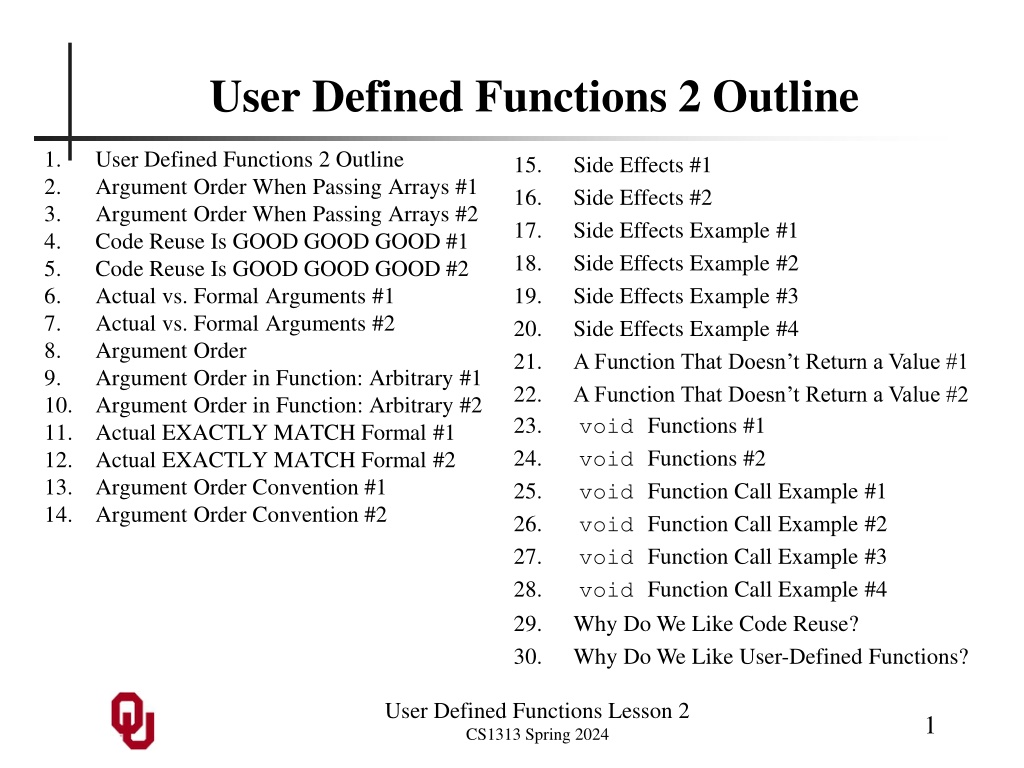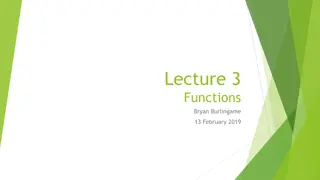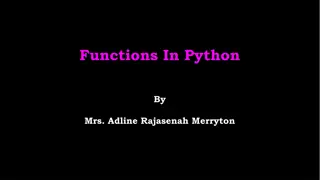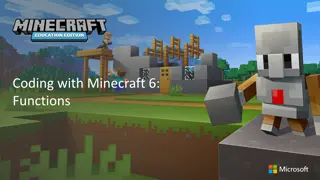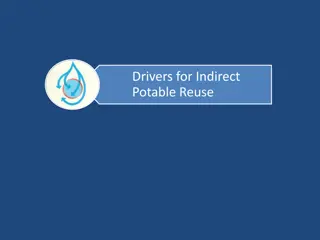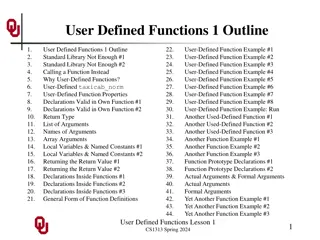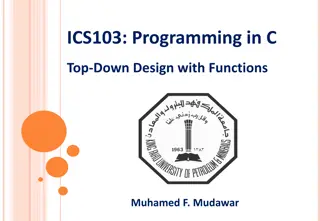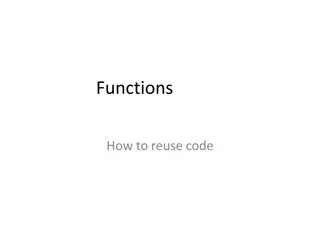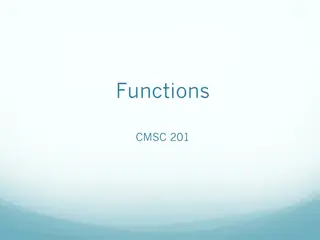Understanding User-Defined Functions and Code Reuse
In this lesson, we delve into user-defined functions, exploring topics such as argument order when passing arrays, the importance of code reuse for efficiency, and the significance of actual versus formal arguments. Through examples and explanations, we unravel the principles behind creating reusable and efficient code structures.
Download Presentation

Please find below an Image/Link to download the presentation.
The content on the website is provided AS IS for your information and personal use only. It may not be sold, licensed, or shared on other websites without obtaining consent from the author. Download presentation by click this link. If you encounter any issues during the download, it is possible that the publisher has removed the file from their server.
E N D
Presentation Transcript
User Defined Functions 2 Outline 1. 2. 3. 4. 5. 6. 7. 8. 9. 10. 11. 12. 13. 14. User Defined Functions 2 Outline Argument Order When Passing Arrays #1 Argument Order When Passing Arrays #2 Code Reuse Is GOOD GOOD GOOD #1 Code Reuse Is GOOD GOOD GOOD #2 Actual vs. Formal Arguments #1 Actual vs. Formal Arguments #2 Argument Order Argument Order in Function: Arbitrary #1 Argument Order in Function: Arbitrary #2 Actual EXACTLY MATCH Formal #1 Actual EXACTLY MATCH Formal #2 Argument Order Convention #1 Argument Order Convention #2 15. 16. 17. 18. 19. 20. 21. 22. 23. 24. 25. 26. 27. 28. 29. 30. Side Effects #1 Side Effects #2 Side Effects Example #1 Side Effects Example #2 Side Effects Example #3 Side Effects Example #4 A Function That Doesn t Return a Value #1 A Function That Doesn t Return a Value #2 void Functions #1 void Functions #2 void Function Call Example #1 void Function Call Example #2 void Function Call Example #3 void Function Call Example #4 Why Do We Like Code Reuse? Why Do We Like User-Defined Functions? User Defined Functions Lesson 2 CS1313 Spring 2024 1
Argument Order When Passing Arrays #1 float taxicab_norm (float* array, int number_of_elements) When we pass an array to a function as an argument, we also need to pass its length, because the length of the array (for example, in the main function), whether statically declared at compile time or dynamically allocated at runtime, is not automatically known by the function. When passing an array as a function argument and therefore passing the length of the array as well it doesn t matter what order the formal arguments appear in the function s formal argument list, as long as they match the actual argument list. User Defined Functions Lesson 2 CS1313 Spring 2024 2
Argument Order When Passing Arrays #2 float taxicab_norm (float* array, int number_of_elements) When passing an array as a function argument and therefore passing the length of the array as well it doesn t matter what order the formal arguments appear in the function s formal argument list. HOWEVER,it matters very much that the order of the formal arguments in the function s formal argument list EXACTLY MATCH the order of the actual arguments in the function call. IMPORTANT NOTE: The length argument MUST be an int. User Defined Functions Lesson 2 CS1313 Spring 2024 3
Code Reuse Is GOOD GOOD GOOD #1 We like to make our programming experiences reasonably efficient. Often, we find ourselves doing a particular task the same way in many different contexts. It doesn t make sense, from a software development point of view, to have to type in the same piece of source code over and over and over. So, in solving a new problem that is, in writing a new program we want to be able to reuse as much existing source code as we possibly can. Not surprisingly, this is called code reuse. User Defined Functions Lesson 2 CS1313 Spring 2024 4
Code Reuse Is GOOD GOOD GOOD #2 Code reuse is GOOD GOOD GOOD. It makes us happy as programmers, because: 1. We can get to the solution of a new problem much more quickly. 2. We can thoroughly test and debug a piece of source code that does a common, well-defined task, and then be confident that it will work well in a new context. User Defined Functions Lesson 2 CS1313 Spring 2024 5
Actual vs. Formal Arguments #1 In our cube root examples, we ve seen function calls that look like this: cube_root_value1 = cube_root(input_value1); We say that: this assignment statement calls the user-defined function cube_root using as its actual argumentthe variable input_value1 which corresponds to the function definition s formal argumentbase and returns the cube root of the value stored in the variable input_value1 into the variable named cube_root_value1. User Defined Functions Lesson 2 CS1313 Spring 2024 6
Actual vs. Formal Arguments #2 The actual argumentis the argument that appears in the call to the function (for example, in the main function). The formal argumentis the argument that appears in the definition of the function. Not surprisingly, the mathematical case is the same. In a mathematical function definition like f(x) = x + 1 if we want the value of f(1) then x is the formal argument of the function f, and 1 is the actual argument. User Defined Functions Lesson 2 CS1313 Spring 2024 7
Argument Order Suppose that a function has multiple arguments. Does their order matter? No, yes and yes. No, in the sense that the order of arguments in the function definition is arbitrary. Yes, in the sense that the order of the formal arguments in the function definition must EXACTLY MATCH the order of the actual arguments in the function call. Yes, in the sense that it s a good idea to set a convention for how you re going to order your arguments, and then to stick to that convention. User Defined Functions Lesson 2 CS1313 Spring 2024 8
Argument Order in Function: Arbitrary #1 float taxicab_norm (float* array, int number_of_elements) { /* taxicab_norm */ const float initial_sum = 0.0; const int minimum_number_of_elements = 1; const int first_element = 0; const int program_failure_code = -1; float taxicab_norm_value; int element; if (number_of_elements < minimum_number_of_elements) { printf("ERROR: can't have an array of length %d:\n", number_of_elements); printf(" it must have at least %d element.\n", minimum_number_of_elements); exit(program_failure_code); } /* if (number_of_elements < ...) */ if (array == (float*)NULL) { printf("ERROR: can't calculate the taxicab norm of "); printf("a nonexistent array.\n"); exit(program_failure_code); } /* if (array == (float*)NULL) */ taxicab_norm_value = initial_sum; for (element = first_element; element < number_of_elements; element++) { taxicab_norm_value += fabs(array[element]); } /* for element */ return taxicab_norm_value; } /* taxicab_norm */ User Defined Functions Lesson 2 CS1313 Spring 2024 9
Argument Order in Function: Arbitrary #2 float taxicab_norm (int number_of_elements, float* array) { /* taxicab_norm */ const float initial_sum = 0.0; const int minimum_number_of_elements = 1; const int first_element = 0; const int program_failure_code = -1; float taxicab_norm_value; int element; if (number_of_elements < minimum_number_of_elements) { printf("ERROR: can't have an array of length %d:\n", number_of_elements); printf(" it must have at least %d element.\n", minimum_number_of_elements); exit(program_failure_code); } /* if (number_of_elements < ...) */ if (array == (float*)NULL) { printf("ERROR: can't calculate the taxicab norm of "); printf("a nonexistent array.\n"); exit(program_failure_code); } /* if (array == (float*)NULL) */ taxicab_norm_value = initial_sum; for (element = first_element; element < number_of_elements; element++) { taxicab_norm_value += fabs(array[element]); } /* for element */ return taxicab_norm_value; } /* taxicab_norm */ User Defined Functions Lesson 2 CS1313 Spring 2024 10
Actual EXACTLY MATCH Formal #1 #include <stdio.h> ... int main () { /* main */ ... list1_input_value_taxicab_norm = taxicab_norm(list1_input_value, number_of_elements); ... } /* main */ float taxicab_norm (float* array, int number_of_elements) { /* taxicab_norm */ ... } /* taxicab_norm */ User Defined Functions Lesson 2 CS1313 Spring 2024 11
Actual EXACTLY MATCH Formal #2 #include <stdio.h> ... int main () { /* main */ ... list1_input_value_taxicab_norm = taxicab_norm(number_of_elements, list1_input_value); ... } /* main */ float taxicab_norm (int number_of_elements, float* array) { /* taxicab_norm */ ... } /* taxicab_norm */ User Defined Functions Lesson 2 CS1313 Spring 2024 12
Argument Order Convention #1 In general, it s good practice to pick a convention for how you will order your argument lists, and to stick with that convention. The reason for this is that, as you develop your program, you ll jump around a lot from place to place in the program, and you ll forget what you did in the other parts of the program. Pick a convention for argument order, and stick to it. User Defined Functions Lesson 2 CS1313 Spring 2024 13
Argument Order Convention #2 Here s an example argument order convention: 1. all arrays in alphabetical order, and then 2. all lengths of arrays in the same order as those arrays, and then 3. all non-length scalars, in alphabetical order. Given this convention: when you define a new function, you know what order to use in the function definition; when you call a function that you ve defined, you know what order to use in the function call. User Defined Functions Lesson 2 CS1313 Spring 2024 14
Side Effects #1 A side effectof a function is something that the function does other than calculate and return its return value, and that affects something other than the values of local variables. User Defined Functions Lesson 2 CS1313 Spring 2024 15
Side Effects #2 int input_number_of_elements () { /* input_number_of_elements */ const int minimum_number_of_elements = 1; const int program_failure_code = -1; int number_of_elements; printf("How many elements would you like "); printf("the array to have (at least %d)?\n", minimum_number_of_elements); scanf("%d", &number_of_elements); if (number_of_elements < minimum_number_of_elements) { printf(You can't have fewer than "); printf("%d elements.\n", minimum_number_of_elements); exit(program_failure_code); } /* if (number_of_elements < ... ) */ return number_of_elements; } /* input_number_of_elements */ This function has the side effect of outputting a prompt message to the user, as well as of idiotproofing (that is, outputting an error message and terminating if needed). User Defined Functions Lesson 2 CS1313 Spring 2024 16
Side Effects Example #1 % cat userarray.c #include <stdio.h> #include <stdlib.h> int main () { /* main */ const int first_element = 1; const int program_success_code = 0; const int program_failure_code = -1; float* element_value = (float*)NULL; int number_of_elements; int index; int input_number_of_elements(); Function prototype User Defined Functions Lesson 2 CS1313 Spring 2024 17
Side Effects Example #2 number_of_elements = input_number_of_elements(); printf("The number of elements that you\n"); printf(" plan to input is %d.\n", number_of_elements); element_value = (float*)malloc(sizeof(float) * number_of_elements); if (element_value == (float*)NULL) { printf("ERROR: couldn't allocate the array\n"); printf(" named element_value of %d elements.\n", number_of_elements); exit(program_failure_code); } /* if (element_value == (float*)NULL) */ free(element_value); element_value = (float*)NULL; return program_success_code; } /* main */ User Defined Functions Lesson 2 CS1313 Spring 2024 18
Side Effects Example #3 int input_number_of_elements () { /* input_number_of_elements */ const int minimum_number_of_elements = 1; const int program_failure_code = -1; int number_of_elements; printf("How many elements would you like\n"); printf(" the array to have (at least %d)?\n", minimum_number_of_elements); scanf("%d", &number_of_elements); if (number_of_elements < minimum_number_of_elements) { printf(You can't have fewer than "); printf("%d elements.\n", minimum_number_of_elements); exit(program_failure_code); } /* if (number_of_elements < ... ) */ return number_of_elements; } /* input_number_of_elements */ User Defined Functions Lesson 2 CS1313 Spring 2024 19
Side Effects Example #4 % gcc -o userarray userarray.c inputnumelts.c % userarray How many elements would you like the array to have (at least 1)? 5 The number of elements that you plan to input is 5. User Defined Functions Lesson 2 CS1313 Spring 2024 20
A Function That Doesnt Return a Value #1 int input_elements (float* element_value, int number_of_elements) { /* input_elements */ const int first_element = 0; int index; printf("What are the %d elements ", number_of_elements); printf("of the array?\n"); for (index = first_element; index < number_of_elements; index++) { scanf("%f", &element_value[index]); } /* for index */ return ???; } /* input_elements */ What on earthare we going to return? User Defined Functions Lesson 2 CS1313 Spring 2024 21
A Function That Doesnt Return a Value #2 What on earthare we going to return? The best answer is, we re not going to return anything. But if we re not returning anything, then what return type should the function have? In C, we have a special data type to use as the return type of a function that doesn t return anything:void. Thus, avoid function is a function whose return type is void, and which therefore returns nothing at all. User Defined Functions Lesson 2 CS1313 Spring 2024 22
void Functions #1 A void function is exactly like a typical function, except that its return type is void, which means that it returns nothing at all. void input_elements (float* element_value, int number_of_elements) { /* input_elements */ const int first_element = 0; int index; printf("What are the %d elements ", number_of_elements); printf("of the array?\n"); for (index = first_element; index < number_of_elements; index++) { scanf("%f", &element_value[index]); } /* for index */ } /* input_elements */ User Defined Functions Lesson 2 CS1313 Spring 2024 23
void Functions #2 Avoid function is invoked simply by the name of the function and its arguments (for example, in the main function): input_elements(element_value, number_of_elements); Notice that a void function must have side effects to be useful. User Defined Functions Lesson 2 CS1313 Spring 2024 24
void Function Call Example #1 #include <stdio.h> #include <stdlib.h> int main () { /* main */ const int first_element = 0; const int program_failure_code = -1; const int program_success_code = 0; float* element_value = (float*)NULL; int number_of_elements; int index; int input_number_of_elements(); void input_elements(float* element_value, int number_of_elements); User Defined Functions Lesson 2 CS1313 Spring 2024 25
void Function Call Example #2 number_of_elements = input_number_of_elements(); element_value = (float*)malloc(sizeof(float) * number_of_elements); if (element_value == (float*)NULL) { printf("ERROR: couldn't allocate the array\n"); printf(" named element_value of "); printf("%d elements.\n", number_of_elements); exit(program_failure_code); } /* if (element_value == (float*)NULL) */ User Defined Functions Lesson 2 CS1313 Spring 2024 26
void Function Call Example #3 input_elements(element_value, number_of_elements); printf("The %d elements are:\n", number_of_elements); for (index = first_element; index < number_of_elements; index++) { printf("%f ", element_value[index]); } /* for index */ printf("\n"); free(element_value); element_value = (float*)NULL; return program_success_code; } /* main */ User Defined Functions Lesson 2 CS1313 Spring 2024 27
void Function Call Example #4 % gcc -o userarray2 userarray2.c inputnumelts.c \ inputarrayvoidfunc.c % userarray2 How many elements would you like the array to have (at least 1)? 5 What are the 5 elements of the array? 1 8 25 27 32 The 5 elements are: 1.000000 8.000000 25.000000 27.000000 32.000000 User Defined Functions Lesson 2 CS1313 Spring 2024 28
Why Do We Like Code Reuse? 1. Bug avoidance: Since we don t have to retype the function from scratch every time we use it, we aren t constantly making new and exciting typos. 2. Implementation efficiency: We aren t wasting valuable programming time ($8 - $100s per programmer per hour) on writing commonly used functions from scratch. 3. Verification: We can test a function under every conceivable case, so that we re confident that it works, and then we don t have to worry about whether the function has bugs when we use it in a new program. User Defined Functions Lesson 2 CS1313 Spring 2024 29
Why Do We Like User-Defined Functions? 1. Code Reuse 2. Encapsulation: We can write a function that packages an important concept (for example, the cube root). That way, we don t have to litter our program with cube root calculations. So, someone reading our program will be able to tell immediately that, for example, a particular statement has a cube root in it, instead of constantly having to figure out what pow(x, 1.0/3.0) means. 3. Modular Programming: If we make a bunch of encapsulations, then we can have our main function simply call a bunch of functions. That way, it s easy for someone reading our code to tell what s going on in the main function, and then to look at individual functions to see how they work. User Defined Functions Lesson 2 CS1313 Spring 2024 30
